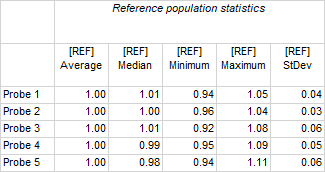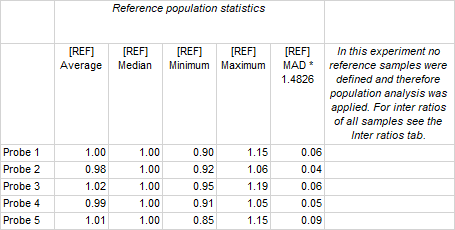A Reference Sample Quality (RSQ) warning or error indicates that one or more probes were too variable in the sample population used for normalisation (more information). The Reference sample quality sheet in the Ratios.xlsx Excel file created by Coffalyser digitalMLPA™ can be used to identify the sample(s) causing the RSQ warning or error.
Finding the variable probe(s)
The Reference sample quality sheet in the Ratios.xlsx Excel file shows the following for each probe:
- The average, median, minimum, and maximum inter ratio of the reference sample population.
- If there were dedicated reference samples in the experiment: the standard deviation (StDev) of the inter ratios of the reference samples (first example below).
- If there were no dedicated reference samples in the experiment: the median absolute deviation (MAD) of the inter ratios of all samples used for normalisation (test and undefined factors) corrected by a factor of 1.4826 to make the value comparable to the standard deviation (second example below).
- Probes that target the X- or Y-chromosome (outside of PARs) are only normalised to samples from the same sex (see below for details and information about a known limitation of the current versions of Coffalyser digitalMLPA).


If the standard deviation or corrected MAD of a probe is too high, the value is highlighted in orange (warning) or red (error) to indicate that the probe exceeded the limit of acceptable variation. If dedicated reference samples were used, the sheet also shows the inter ratios of each probe in all reference samples. Deviating ratios are highlighted to help identify reference sample(s) with outliers that may have caused the RSQ warning or error for a particular probe. The colours that are used are the same as those on the Inter ratios sheet (see the User Manual).

If the experiment did not include dedicated reference samples, the Inter ratios sheet can be used to find the sample(s) with variable ratio(s) for the variable probe(s).
Solving RSQ warnings or errors
RSQ warnings or errors can sometimes be solved by excluding the variable dedicated reference sample(s) from the analysis. However, it is critical that sufficient reference samples remain in the analysis.
If no dedicated reference samples were defined, particularly in experiments with a low number of samples, the inclusion of dedicated reference samples can often solve RSQ warnings or errors (more information).
Not all RSQ warnings and errors can be solved with adjustments of the reference sample selection, e.g. when a probe is really variable throughout the entire experiment due to reaction issues. Contact us for help with variable probes.
Probes on the X- or Y-chromosome
Probes that target the X- or Y-chromosome outside of the pseudoautosomal regions (PARs) are only normalised to reference samples of the same sex as the test sample. In an experiment with mixed sexes, these probes may be variable in just the male or just the female reference samples. This can lead to differences in RSQ warnings or errors per sex (e.g. warnings for all male samples but not for all female samples).
Known limitations of Coffalyser digitalMLPA v211020.1245 and later
Coffalyser digitalMLPA v211020.1245 and later have two known limitations in the calculation of the Reference population statistics on the Reference sample quality sheet.
- Statistics for X- and Y-chromosome probes (outside of PARs) are only based on reference samples that match the sex of the first sample in the analysis. Identification of variable X- and Y-chromosome probes in the reference population of both sexes requires manual calculations, which are described in this article.
- Reference population statistics may be absent if the first sample in the analysis was omitted from the comparative analysis due to an error (e.g. when a no-DNA sample was not indicated as such in the experiment's definition). This can be corrected by repeating the analysis using the correct sample type, or by omitting the sample that caused the error from the analysis.
These limitations will be addressed in future versions of Coffalyser digitalMLPA.